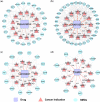Systems Pharmacology-Based Discovery of Natural Products for Precision Oncology Through Targeting Cancer Mutated Genes
- PMID: 28294568
- PMCID: PMC5356618
- DOI: 10.1002/psp4.12172
Systems Pharmacology-Based Discovery of Natural Products for Precision Oncology Through Targeting Cancer Mutated Genes
Abstract
Massive cancer genomics data have facilitated the rapid revolution of a novel oncology drug discovery paradigm through targeting clinically relevant driver genes or mutations for the development of precision oncology. Natural products with polypharmacological profiles have been demonstrated as promising agents for the development of novel cancer therapies. In this study, we developed an integrated systems pharmacology framework that facilitated identifying potential natural products that target mutated genes across 15 cancer types or subtypes in the realm of precision medicine. High performance was achieved for our systems pharmacology framework. In case studies, we computationally identified novel anticancer indications for several US Food and Drug Administration-approved or clinically investigational natural products (e.g., resveratrol, quercetin, genistein, and fisetin) through targeting significantly mutated genes in multiple cancer types. In summary, this study provides a powerful tool for the development of molecularly targeted cancer therapies through targeting the clinically actionable alterations by exploiting the systems pharmacology of natural products.
© 2017 The Authors CPT: Pharmacometrics & Systems Pharmacology published by Wiley Periodicals, Inc. on behalf of American Society for Clinical Pharmacology and Therapeutics.
Figures




Similar articles
-
Cardio-Oncology: How New Targeted Cancer Therapies and Precision Medicine Can Inform Cardiovascular Discovery.Circulation. 2015 Dec 8;132(23):2248-58. doi: 10.1161/CIRCULATIONAHA.115.010484. Circulation. 2015. PMID: 26644247 Free PMC article. Review.
-
Individualized network-based drug repositioning infrastructure for precision oncology in the panomics era.Brief Bioinform. 2017 Jul 1;18(4):682-697. doi: 10.1093/bib/bbw051. Brief Bioinform. 2017. PMID: 27296652 Review.
-
Precision medicine in pediatric oncology.Curr Opin Pediatr. 2018 Feb;30(1):17-24. doi: 10.1097/MOP.0000000000000570. Curr Opin Pediatr. 2018. PMID: 29189430 Free PMC article. Review.
-
Defining precision: The precision medicine initiative trials NCI-MPACT and NCI-MATCH.Curr Probl Cancer. 2017 May-Jun;41(3):182-193. doi: 10.1016/j.currproblcancer.2017.02.001. Epub 2017 Feb 11. Curr Probl Cancer. 2017. PMID: 28372823
-
Quantitative and Systems Pharmacology. 1. In Silico Prediction of Drug-Target Interactions of Natural Products Enables New Targeted Cancer Therapy.J Chem Inf Model. 2017 Nov 27;57(11):2657-2671. doi: 10.1021/acs.jcim.7b00216. Epub 2017 Oct 13. J Chem Inf Model. 2017. PMID: 28956927 Free PMC article.
Cited by
-
Systems Pharmacology for Investigation of the Mechanisms of Action of Traditional Chinese Medicine in Drug Discovery.Front Pharmacol. 2019 Jul 11;10:743. doi: 10.3389/fphar.2019.00743. eCollection 2019. Front Pharmacol. 2019. PMID: 31379563 Free PMC article. Review.
-
A Systems Pharmacology Approach Uncovers Wogonoside as an Angiogenesis Inhibitor of Triple-Negative Breast Cancer by Targeting Hedgehog Signaling.Cell Chem Biol. 2019 Aug 15;26(8):1143-1158.e6. doi: 10.1016/j.chembiol.2019.05.004. Epub 2019 Jun 6. Cell Chem Biol. 2019. PMID: 31178408 Free PMC article.
-
In silico Identification and Mechanism Exploration of Hepatotoxic Ingredients in Traditional Chinese Medicine.Front Pharmacol. 2019 May 3;10:458. doi: 10.3389/fphar.2019.00458. eCollection 2019. Front Pharmacol. 2019. PMID: 31130860 Free PMC article.
-
In silico identification of natural products from Traditional Chinese Medicine for cancer immunotherapy.Sci Rep. 2021 Feb 8;11(1):3332. doi: 10.1038/s41598-021-82857-2. Sci Rep. 2021. PMID: 33558586 Free PMC article. Review.
-
Integrated network pharmacology and experimental analysis unveil multi-targeted effect of 18α- glycyrrhetinic acid against non-small cell lung cancer.Front Pharmacol. 2022 Oct 12;13:1018974. doi: 10.3389/fphar.2022.1018974. eCollection 2022. Front Pharmacol. 2022. PMID: 36313358 Free PMC article.
References
-
- Toniatti, C. , Jones, P. , Graham, H. , Pagliara, B. & Draetta, G. Oncology drug discovery: planning a turnaround. Cancer Discov. 4, 397–404 (2014). - PubMed
-
- Rodrigues, T. , Reker, D. , Schneider, P. & Schneider, G. Counting on natural products for drug design. Nat. Chem. 8, 531–541 (2016). - PubMed
-
- Li, J.W. & Vederas, J.C. Drug discovery and natural products: end of an era or an endless frontier? Science 325, 161–165 (2009). - PubMed
-
- DeCorte, B.L. Underexplored opportunities for natural products in drug discovery. J Med. Chem. 59, 9295–9304 (2016). - PubMed
Publication types
MeSH terms
Substances
Grants and funding
LinkOut - more resources
Full Text Sources
Other Literature Sources

